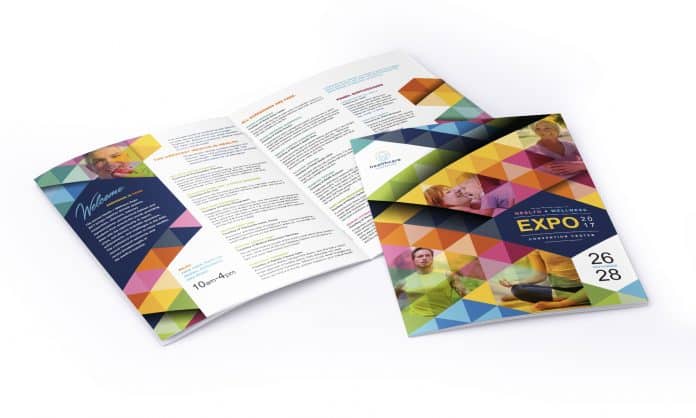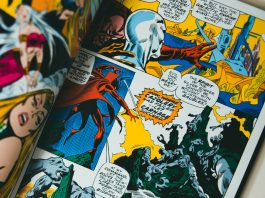Last updated on August 13th, 2024 at 02:12 pm
Have you seen a booklet bound with 2 “staples” down the spine? That’s a saddle-stitched binding! Saddle-stitched binding is a very popular binding method for booklet printing, catalog printing, magazine printing… the list goes on and on! They’re very popular among customers due to how economical they are to design, print, and bind. So, what is saddle stitch binding, and why is it so popular?

The saddle stitch binding definition explains it: no staples are involved (I dare you to try to staple a hundred of them by hand!) Saddle-stitched booklets are “stitched” using a spool of long metal wire. The wire is pushed through the sheet (in a motion similar to that of a sewing machine). Then, the wire is folded into something that is basically a staple.

There are many different kinds of equipment used to do saddle-stitched binding, but the principle behind all of them is the same. They range from low-volume machines that are slow and manually operated to fast, automatic, high-volume machines. You can also emulate saddle-stitched binding with a long-neck stapler, but it is time-consuming and inconsistent.
Visit Printivity.com for an instant quote and to order saddle stitch booklet printing.
What Are the Benefits of Saddle Stitching?
What is saddle stitch binding’s biggest selling point? The saddle stitch binding method is great for a lot of reasons, including:
- Affordability: Saddle stitching is cost-effective, which is perfect for projects where budget is a significant factor.
- Speed: Expect rapid turnaround times for saddle-stitched projects. Speed is key for urgent projects or regular publications like magazines.
- Functionality: Saddle-stitched books lay flat, ensuring that spreads with images across two pages display seamlessly.
- Flexibility: This method works well for small and large page counts and allows for economical short runs with substantial savings.
- Design versatility: Opting for a “self-cover,” where the cover and interior pages use the same paper stock, maximizes cost-efficiency.
- Lightweight distribution: Minimal bulk and weight make these books cheaper to distribute, a boon for bulk shipping.
- Customization: Choose from an extensive range of paper options to elevate the aesthetic of your booklet or brochure.
How the Stitch Works
There are many steps in the saddle stitch binding process. Let’s start by focusing on the part of the saddle stitch equipment that does the binding. To actually bind books, you need:
- A stack of collated sheets of paper
- A saddle stitch head
- A spool of saddle stitch wire
Here is what happens in the stitching unit of the saddle-stitch machine:
- The stack of collated sheets (guts and covers) get fed into the unit.
- The stack of sheets is jogged—top to bottom and left to right—to make sure they’re neatly stacked.
- Both saddle stitch heads pull a bit of wire to pierce through the stack of paper.
- Then, both saddle-stitch heads descend and one end of the wire gets through, folded, cut, and the other end is pushed in.
With this, the saddle stitch bind is complete! It’s ready to go to the next stations for folding and finally cutting.
Saddle Stitch Tip: How Pages of a Booklet are Paginated
Saddle-stitched booklets need to be paginated in a particular way to ensure the pages end up in the correct sequence after folding. This often surprises people when they try printing a saddle-stitched booklet.
The “stack of collated sheets” I mentioned earlier needs to be paginated so that all the opposite pages are paired up into spreads. Let’s say you’re creating a 16-page saddle-stitched booklet. There are going to be 4 sheets of paper, folded in half. Here’s what I mean:
- Sheet 1/Side 1: Pages 1 (front cover) & 16 (back cover)
- Sheet 1/Side 2: Pages 2 (inside front cover) & 15 (inside back cover)
- Sheet 2/Side 1: Pages 3 & 14
- Sheet 2/Side 2: Pages 4 & 13
- Sheet 3/Side 1: Pages 5 & 12
- Sheet 3/Side 2: Pages 6 & 11
- Sheet 4/Side 1: Pages 7 & 10
- Sheet 4/Side 2: Pages 8 & 9 (This is the centerfold spread)
What is the Best Page Count for Saddle Stitch Binding?
So, how does saddle stitch binding impact the page count of a project? To maximize the functionality and aesthetics of your publications, consider these guidelines on page count for saddle stitch binding:
- Multiples of four: This binding method is perfect for 4 to 64 pages. Every booklet’s page count must align with the “rule of four,” as folded sheets form four pages. This ensures the booklet can lay flat and maintain a clean appearance.
- High page count limitations: Books over 64 pages may not lay flat, affecting usability and visual appeal.
- Paper weight: Using standard weights for interior pages and heavier covers improves the durability and functionality of the books.
Saddle Stitch vs. Perfect Bound Books
Saddle stitch binding is the go-to for shorter documents like brochures and small catalogs. In contrast, perfect binding glues the edges of the pages together at the spine, providing a neat and durable finish suitable for thicker publications such as novels and textbooks. Deciding between saddle-stitched and perfect binding? Here are some factors to consider:
- Spine printing: Unlike saddle-stitched books, perfect binding offers a printable spine, enhancing the book’s appearance.
- Page capacity: Saddle stitching is ideal for up to 64 pages, while perfect bound books accommodate higher page counts.
- Speed: Saddle-stitched publications are quicker to produce, making them a faster solution than perfect binding.
- Cost efficiency: Saddle-stitched booklets generally cost less than perfect binding for production and shipping.
- Durability and style: For a more refined look and enhanced durability, perfect binding outshines saddle-stitched.
- Safety: Perfect binding is safer and more durable for children’s books, making it the preferred choice.
Each binding technique has its distinct advantages. The right choice will depend on your project’s page count, budget, and other requirements. For more details, check out Printivity’s perfect bound printing page.
Other Kinds of Preparation for a Saddle-Stitched Booklet
There are two other types of preparation and finishing that a professional printing company like Printivity will do for a booklet with a saddle-stitched binding.
First, cardstock covers are creased down the center of the spine. This makes the paper fold better, which alleviates cracking on the paper, toner, and ink.

Second, saddle-stitched booklets are face-trimmed after being bound. This is more than just a trim for full bleed booklets. This is to trim off the “creep” that occurs during the folding. When a stack of paper is folded in half, each inner sheet of paper gets pushed out a tiny amount. If you don’t do a face-trim on the creep, the sheets in the booklet do not look neat.
Order Saddle Stitched Booklets at Printivity!
Saddle-stitched booklets should be the go-to product for your next trade show! Contact Printivity to see if this cost effective, quick production turnaround, professional booklet is the right choice for your next project.




